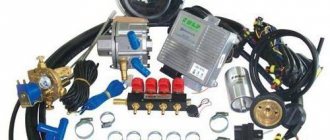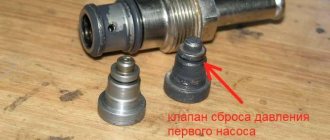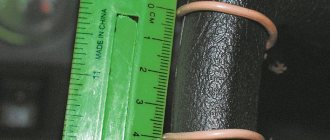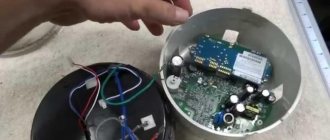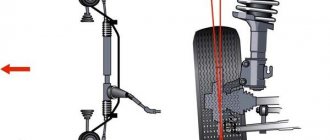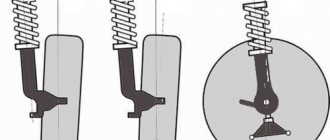HBO adjustment 2nd generation
After successfully installing a 2nd generation LPG on a car, and passing a test to ensure the functionality of its components and the absence of leaks of the propane-butane mixture (detected by “soaking” the connections or using a gas analyzer), the time comes for the need to adjust the equipment for further successful operation. The HBO adjustment is carried out sequentially in several steps, let's take a closer look.
Stages
Adjusting the 2nd generation HBO consists of several simple steps:
- Adjusting the sensitivity of the gearbox.
- Adjusting the propane-butane mixture dispenser.
- Adjusting the idle speed when operating on a propane-butane mixture.
- Delay in the operation of the automatic shutdown when switching the operation of the car engine from gasoline to a gas mixture for carburetor cars. Or the number of revolutions at which the engine will switch from running on gasoline to running on a propane-butane mixture, provided that the fuel type switch button is set to the “automatic” position.
Before starting the adjustment, check:
- There is a sufficient level of coolant in the vehicle's expansion tank. If necessary, liquid must be added.
- Check and, if necessary, adjust the operation of a car engine on gasoline.
- Since the engine, when running on a propane-butane mixture, is very sensitive to air filter contamination, the air filter is replaced with a new one or blown out.
- No gas leaks. It is checked mainly by applying soap foam - by washing all gas compounds. If leaks are detected (in such places soap bubbles form from the foam), the connection is disassembled and the leak is eliminated. Then the reassembled connection must be checked again.
- Reliability of fastening of all clamps and nuts.
- Reliability and correct connection and absence of short circuits of all electrical appliances of HBO2 (electric valves, buttons).
- Check the presence of gasoline in the gas tank.
- Fill the cylinder with a propane-butane mixture.
Step-by-step instructions for setting up gas equipment
The vehicle must first be warmed up to operating level. Then remove the load (heating, air conditioning, air conditioning, etc.) from the engine so that the car remains idling. Before entering the parameters menu, you need to connect to the gas equipment using a special cord. If necessary, the software must be updated to the latest firmware version. Algorithm for setting up Digitronic gas equipment using special software:
- Set the basic parameters of the car (number of cylinders, engine type, etc.), and in the “GAS Controller Settings” tab select the type of injectors, temperature sensors, etc.
- In the calibration section it is required to indicate the operating and emergency gas pressure. Calibration setup is done automatically using the ISA-2 adaptation tool. It must be carried out on a warm internal combustion engine (internal combustion engine).
- When the procedure is completed, the system prompts you to take a ride to set up the gas map. While driving, a map consisting of multi-colored cells will be displayed on the laptop monitor. It is necessary that the maximum number of them turn black.
- After receiving sufficient information on the use of gasoline fuel, you should switch to gas and continue driving.
Filling out each card usually requires driving several kilometers. The curve of the petrol and gas maps should be as close as possible. If they do not match, you need to adjust the coefficient:
- Place a mark on the orange curved line at the point where the two graphs diverge.
- Place a point on the orange curve at the convergence of the blue and green lines.
- Select the area of greatest deviation of the gas and gasoline curves. This point must be clamped and moved so as to minimize misalignment.
- Make another trip by car to generate new maps. If they do not match again, you need to try the whole procedure again.
The coincidence of the map graphs is not a 100% guarantee of the correct fuel mixture. After the initial setup, you need to drive the car for some time to observe the “behavior” of the curve. If necessary, additional steps must be taken to obtain the best result.
Selecting the right gas mixture
To determine the optimal fuel characteristics, it is necessary:
- Start the car and warm up the gas fuel and gearbox to operating condition.
- Switch the vehicle to gasoline and let the engine run for about 10 minutes. Observe in the program how the injection time changes. It is recommended to additionally monitor the fuel trim and lambda.
- Switch the car to gas and check how the fuel injection timing changes. An increase indicates a poor gas mixture, so the electronic control unit tries to enrich it. It is necessary to ensure that the injection does not change when switching from gasoline to gas. To do this, you need to move the orange curve up or down until the desired result is achieved.
A deviation of 10% is allowed. The software allows you to adjust other parameters in order to more accurately configure the operation of gas equipment. It is not easy to set the correct characteristics on your own, so it is better to contact a specialist who will optimize the operation of a car on a gas fuel system.
specializes in installation and maintenance of gas equipment in St. Petersburg. Experienced craftsmen will quickly and accurately adjust gas equipment to obtain optimal performance.
If necessary, company managers will answer your questions and fill out a preliminary application. If you require installation or adjustment of 4th generation HBO, call +7 (812) 777-0-180.
Adjustment
After completing the checks, we begin adjusting the system.
- By switching the toggle switch on the button for selecting the type of fuel on which the car operates to the “Gasoline” position, we start the car engine in normal mode and warm it up with gasoline to operating temperature (80-90°C).
- While the engine warms up to operating temperature, unscrew the screw/screws on the dispenser to completely open the channel for the gas mixture to enter the mixer.
- We tighten the screw for supplying the mixture to chamber 2 until it stops.
- 1st – idle speed screw; it regulates the amount of propane-butane mixture that will be supplied to the engine when the gearbox diaphragm is closed.
- 2nd sensitivity screw, which regulates the opening moment of the membrane and the gas pressure when pressing the throttle.
- Before starting adjustments, turn screw 1 all the way, then unscrew it 1 turn, screw 2 turn it all the way and unscrew it 3 turns.
- When the engine reaches operating temperature (80-90°C), we move the fuel type switch to the neutral position (for engines equipped with a carburetor) to produce gasoline from the float chamber.
- After the remaining gasoline has been completely exhausted from the float chamber (the engine is trying to stall), we move the toggle switch for the fuel mode selection button to the “GAS” position.
- Using screw 1, we try to set the idle speed to about 750-850 rpm. Preventing the engine from stalling using the throttle.
- After setting a stable idle speed, we begin to carefully tighten screw 2 and look for the moment when the car begins to change its operation, trying to stall.
- Next, by opening the throttle, we bring the engine speed to 3000 -3500, maintain them, and begin to tighten the feed screw on the mixer (with 2 chambers, tighten the feed screw “I” of the 1st chamber) until we hear that the engine becomes “sluggish” - this is a transitional moment .
- After detecting this behavior of the engine, unscrew the feed screw on the mixer by 0.5 - 0.75 turns and leave it like that.
- Again, use screw 1 on the gearbox to set the stable idle speed to about 750-850 rpm. Unscrew the mixture supply screw on the mixer “II” into chamber 2 by 1 turn. We check the settings of the gearbox and dispenser of the car while driving, and if necessary, adjust the settings.
If it is necessary to increase or decrease the speed at which the injection engine itself switches to operating on a propane-butane mixture, you must:
- by turning the adjusting resistance on the switch button, achieve the required value of the desired parameter.
For a carburetor car, the delay time for automatically turning off the gas when starting the engine on a gas mixture is adjusted in the same way by turning the adjusting resistance on the switch button clockwise (decreases), counterclockwise - increases.
This concludes the adjustment of the 2nd generation HBO.
Adjusting the gas on a car
Adjusting gas equipment, or adjusting gas equipment, is often called fine tuning. And this adjustment can be performed by a specialist in this field or by the person whose hands grow from the right place!
Before adjusting the LPG, it is necessary to check some components of the car engine. The compression in the cylinders should be 6.5 kgf/cm2, and the intake tract should be completely sealed, and of course you will check all the wires and spark plugs.
Without this check, adjusting the HBO is simply a waste of time. First, switch the gas reducer to gasoline mode and start the car. After we have warmed up the engine to operating temperature, we set the idle speed to 800 rpm. Then we switch the gearbox to the neutral position. The procedure for adjusting HBO depends on the type of dispenser. Single-section, turn it to maximum, if your system is two-section, then turn the first chamber to maximum, and the second to min. We tighten the idle screw tightly and make 5 turns back.
We switch the button to the “Gas” position, start the car and, using the choke, set the speed to 1500-1700 rpm. Afterwards, we lower the adjustment knob completely so that when the choke is turned off, the engine runs stably.
After this operation, adjusting the gas system means that with the sensitivity screw tightened almost all the way, the engine runs on gas steadily and stably, providing an idle speed of about 1200-1280 rpm, which needs to be reduced to 850-1000 rpm.
The next process of adjusting the gas equipment is adjusting the sensitivity of the gas reducer.
Carefully unscrew the sensitivity bolt, and when it no longer affects the idle speed, screw it back about 2 turns.
We check the LPG adjustment by sharply pressing the gas accelerator: the engine response should be powerful.
Now the most difficult and important adjustment of HBO is the adjustment of the dispenser itself. Here we need an assistant to use the gas pedal to set the engine speed to 3200-3700 rpm.
Adjusting the gas system begins with adjusting the dispenser screw in order to understand where the threshold is at which the speed changes. Having found this point, the screw is turned out in the other direction approximately half a turn. For a two-section dispenser, the first chamber is adjusted in the same way, and the second chamber is reduced to setting the screw position to a quarter.
In some gearboxes, it is possible to adjust the pressure of the first stage at idle speed, using an external pressure gauge, the pressure is approximately 0.38-0.42 kgf/cm2. after which you need to adjust the idle speed again.
The most recent operation of adjusting the HBO is as follows. Press the gas pedal, then about a quarter turn, tighten the adjustment screw. We repeat this process several times until there are no speed drops. As soon as it appears, you need to unscrew the screw again half a turn.
Now we can say that the HBO adjustment is complete. Have a nice ride.
v-mireauto.ru
Do-it-yourself gas system adjustment 2nd generation
Car owners, from their own experience and budget, clearly feel the systematic rise in fuel prices. Finding yourself in such a situation, the only way to save money is to use gas equipment. Particularly lucky car owners managed to deliver it before the cost increased. They equipped the cars with new systems and configured Lovato’s 2nd generation LPG with their own hands. Using the example of setting up equipment from this brand, we will tell you about all the advantages of this choice.
Advantages
Correct adjustment of Lovato 2nd generation LPG in the injector and carburetor can be done with your own hands. In comparison with the new type of gas equipment (4th and 5th generations), the 2nd generation gas equipment gearbox has somewhat lost its relevance. However, this does not indicate that there is no point in using it. Not at all. The present systems have been preserved on almost all cars. And some experts advise using them. The “blame” for this is the outstanding qualities of 2nd generation HBO:
- availability and proven quality of the system. As a result, installation work can be carried out on your own;
- virtually complete absence of electronic components, which radically simplifies adjustment;
- the ability to repair individual components without leaving the garage. Having identified a malfunction, it is not necessary to rush to the service station. Having basic knowledge, you can do all the necessary work with your own hands;
- reasonable price for equipment. The purchase and installation of gas equipment of a higher class is much more expensive. The situation is completely different with 2nd generation gas equipment. Purchasing and further setting up gas equipment for a 2nd generation car really helps out in the current circumstances.
Why is calibration required?
Debugging of gas equipment on cars is mandatory, since otherwise, if you don’t “tighten” the evaporator gearbox, it will be impossible to start the car. This is due to the fact that there is no electronic control unit (ECU) that would have the necessary firmware for a car of a certain make and model. In such equipment, the main task is to set the desired program and check the correctness of its operation. But such gas equipment is mostly installed on injection engines with complex injection technology.
If you do not perform such adjustments on gas equipment of the 1st and 2nd generations, then the incorrect concentration of the gas-air mixture composition may also be supplied to the engine. Because of this, excessive consumption of fuel is observed or the next portion of it burns out at the outlet. Gradually, due to incorrect engine operation, the valves burn out. It should be taken into account that it is impossible to obtain the same fuel consumption in gas and gasoline modes. The consumption of the first will always be 15-20% higher relative to the second, and deviations from this value indicate an incorrect composition of the gas-air mixture.
Adjusting the gas equipment of early generations is mandatory; without it, the engine may not start or the composition of the air-gas mixture will be incorrect. This adjustment is made after installing the equipment on the car, and then every season. It is not difficult to do, but at the last stage - when setting up the dispenser, it is recommended to take someone to help you, since you cannot use the suction.
- What did actor Alexander Abdulov drive?
- Why does the alarm block the engine and how to remove the blocking
- Digital service booklet - goodbye to tangible service history
How is the gearbox controlled?
The 2nd generation Lovato gas reducer has its own characteristics. In general, gas is sensitive to many important points and changes in the operation of the system. It happens that gas equipment was installed, but then increased fuel consumption or other problems with the engine appeared. Let's say the car starts to start slowly or stalls regularly. In this case, it is better to adjust the gearbox.
What needs to be done for this? To familiarize yourself with the process features, you can view a diagram of the existing pins and control components.
Adjust the electric gearbox. You have regulators available - fluid pressure (2) and gas volume (2). The following algorithm of actions must be followed:
- switch to gasoline, turn on the car and warm up the engine to 95 degrees;
- set the speed to 900-1100 rpm and turn off the fuel supply (in this case, gasoline);
- set the initial positions of the adjusting screws: set the dispenser to the extreme mark, turn the XX regulator (2) all the way and then turn it exactly 5 turns, turn the 1 regulator all the way.
Put XX. Namely:
- Switch the control to gas and turn on the car. Using the choke, set the speed of the power unit to around 2 thousand;
- gradually return the choke to its place and unscrew the XX regulator (2). Do this until the maximum engine speed is achieved. What does it mean? Turn screw 2 until the speed stops increasing. When you reach the specified goal, stop;
- operate in the sequence described until the suction is fully recessed;
- turn the adjusting screw (2) evenly. It is necessary to reach such a state that the sum of revolutions becomes presumably the same as when running on gasoline. During adjustment, you must remember that after rotating the regulator, the reaction to changes is not observed instantly, but after some time. This means that you definitely need to take a break.
Adjust the sensitivity of the gearbox. Everything is simple here. Turn the adjusting screw (1) until the XX speed decreases (increases) (again, do not forget about the delays). After this, turn the regulator slightly back - 1.25 rpm. Next, try to apply pressure on the gas. It is perfect if the car immediately responds to your actions.
However, it is important not to forget one more thing. If the adjusting screw “1” was not tightened well enough, it is preferable to leave it untouched. Among other things, provided that the engine capacity is less than 3 liters, then it is also better not to touch the described screw.
Set up the dispenser. To this end:
- set the number of revolutions to 3500. Accordingly, it is preferable to involve an assistant in the process and ask him to press the gas (do not use the choke). No helpers found? It is necessary to secure the throttle cable using a screwdriver;
- Turn the adjusting screw until changes in speed appear. Turn the screw to the left and to the right to make sure that all actions were carried out correctly;
- turn the screw until the speed increases. As soon as the rotation stops producing results, you need to stop;
- From now on, turn the screw 0.75 rpm. from the limit.
- Call an assistant and ask him to press the gas. Do not forget to turn screw 2 by 1/4 turn at the same time. There should be a feeling of a slight decrease in speed;
- turn the sensitivity screw half a turn;
- re-adjust the dispenser.
Measure the level of carbon dioxide in the exhaust. The standard figure is around 0.35%. Are the numbers too high? Turn the XX screw on the gearbox and increase the air injection (for this, use a special screw on the carburetor). If reduced speed is observed, the opposite actions should be taken.
If possible, to correctly configure and adjust the 2nd generation HBO, use a lambda probe emulator. It allows you to see to what extent the work has been done accurately. At the same time, you can make any necessary adjustments along the way.
A simplified method used when repairing 2nd generation gas equipment with your own hands (Lovato brand) is the basics of adjustment (sensitivity bolt in combination with a greed bolt):
- The membrane sensitivity bolt is completely screwed in until it stops slightly.
- Next, unscrew the sensitivity bolt 5 turns from the twisted position.
- The greed bolt (main chamber) on the hose is screwed in, in turn, to a slight stop.
- After this, unscrew the greed bolt 3 turns from the twisted position.
Gas reducer Lovato
In gas-cylinder equipment, the gearbox is given the greatest importance among all components. Its task: to provide the driver with the opportunity to reduce the pressure coming from the cylinder. Repair, namely adjustment, on a car gearbox involves working with one or two regulators: this is the main difference.
In principle, a gas reducer is a primitive pressure regulator designed to independently maintain a standard pressure value based on fuel consumption. As practice shows, the device supports it with minor fluctuations. The pressure decreases slightly with increasing gas flow. This is not a very significant point, but requires attention.
Manufacturer's offer
The Lovato gearbox design is characterized by versatility, simplicity and reliability. For Turkish artisanal producers, the manufacturer is a role model. Almost all generations of Turkish gearboxes have adopted the design of a flattened “drum”, at the ends of which there are two stamped covers. belongs to a family-type enterprise that was founded in the post-war period in conditions of acute fuel shortages. In modern conditions, Lovato is one of the leaders in the global gas cylinder system market. Repair, namely adjustment, of Lovato analogues depends on the following factors:
- generation of mechanism,
- number of regulators,
- fuel system.
Manufacturer product range:
- Lovato propane vacuum reducer for 90 and 140 kW. The device is intended for 1st generation LPG systems on carburetor-type cars with a power of up to 123 horsepower. The reducer is intended exclusively for conversion to propane.
- Lovato electronic propane reducer 90, 140, 170 kW. The device is intended for 1st, 2nd and 3rd generation HBO systems on cars of injection, mono-injection and carburetor types with engine power up to 123 horsepower. The reducer is designed for propane-butane.
- Lovato methane gearbox. The 2nd generation device is used for converting cars and buses to methane fuel.
Gear settings
Repair, namely adjustment, of the gearbox requires orientation in its settings. Propane analogues usually have two regulators, but there are also one. Methane type gearboxes are almost always characterized by one regulator. In their management, these settings are the most problematic.
Repair for the gas generation of gearboxes with one unique setting involves manipulation exclusively with the pressure of the transmitted gas.Lovato gearbox Vehicle owners with particular enthusiasm prefer to “tighten up” the pressure themselves. Having set the only correct and, what is very important, true pressure value, the fuel reducer alone will make it possible to limit gas consumption at operating power due to an element called the greed screw.
Repair has some difficulties when the screw is in the “closed” position. To maintain idle speed in this case, it is necessary to increase the pressure, the process of which involves:
- Checking the gearbox before tuning, namely, whether the “greed screw” is open.
- After the previous stage has been completed, adjustment work can begin.
Lovato gearbox design
Adjustment process
The Lovato gas regulator itself is presented in the form of a screw compressing a spring. In order to install it, you should consider:
- when tightening, the gas supply will be reduced by the reducer,
- when unscrewing, it will grow.
Sometimes screws are found with left-hand threads, most often they are right-hand threads. This moment depends on the designer’s imagination of the manufacturer. To simplify this task slightly, it is necessary to take into account: with any rotation it is characterized by the above characteristics of changes in gas pressure.
Adjusting the idle speed on vehicles is explained by the degree of engine shaking. His calm work indicates that the gearbox repair was carried out competently and efficiently.
So, start the engine and hold the throttle open. Then we smoothly release it and slow down until the power unit stalls. At the same time, do not forget the condition: the gas reducer of the car engine must continue to work. For “dummies”, an explanation: the engine will not stall completely if you start twisting the throttle valve in an arbitrary direction. If worse motor performance is observed, you will have to change the direction of rotation of the gearbox and restore its stable operation.
gear lovato
Setting up HBO yourself. Setting up the gas reducer
Description: Instructions on how to quickly and correctly set up LPG in your car. Normal gas consumption for Lanos... Highway 7.5l, city 11-11.5l. Mixed mode 10l. Regular spark plugs A17DVRM clearance 0.9.
If you liked the video, don’t forget to subscribe to the channel, this will help us make more interesting videos for you. Thank you for watching!
Instructions for adjusting HBO 2nd generation
The first step is to check the engine for air leaks. In order to determine whether it is there or not, you need to buy a can of liquid for cleaning carburetors, and spray this liquid on the areas where there may be suction. Typically, such areas are in the place where the gaskets are located between the carburetor and the manifold, between the intake manifold and the cylinder head, between the air filter housing and the carburetor, as well as at the vacuum connections. If air leaks are detected in this way, then CORRECT ADJUSTMENT OF THE 2nd GENERATION IS IMPOSSIBLE. Fix the problem first, and only then can you make adjustments.
Second phase:
Check the air filter for clogging. It is advisable to replace the air filter before tuning.
Third stage:
You need to check whether the gas is completely shut off when you switch the car to gas. How to check you ask? Yes, it’s easy, you need to move the switch button to position 0, and use up the remaining gasoline from the line and carburetor. After the car has stalled, switch the button to the “Gas” position, and after starting, remove the hose that is located at the output of the gasoline shutoff solenoid valve.
If gasoline does not flow, then everything is fine, and we can start tuning.
Fourth stage:
On a working car, at idle speed, tighten the bypass screw, which is usually gold in color, to the maximum. In the photo it is indicated as “Screw 1”.
If, when tightening it, the idle speed disappears, then add idle speed with screw number 2 until, with screw 1 tightened to the maximum, the machine will idle stably.
Setting up (Adjustment) HBO 2.4 generations: instructions
by yaremenkosanya in Services
Many drivers are switching from gasoline to gas fuel. For this purpose, gas cylinder equipment (LPG) is installed in the car. It needs to be properly maintained and configured. Immediately after installing the system on the car, the gas reducer is adjusted. During operation, you will also need to make adjustments.
As the mileage increases, equipment components wear out. Today, different generations of HBO are used on cars. Therefore, settings are made taking into account the characteristics of the system. To avoid mistakes in the process of adjusting gas equipment, entrust this work to the specialists of the MasterGaz service station (Podol, Kyiv).
Gearbox adjustment
In gas equipment, membranes and valves change their characteristics over time, which leads to excessive gas consumption. The main role in the proper functioning of the system is played by the gearbox. It reduces the pressure of gaseous fuel entering the engine from the cylinder, maintaining it at a given level. Some fluctuations are acceptable.
If the gas flow is stable, the pressure also remains at the same level. But when there is excessive fuel consumption, it drops. This is not critical, but with timely adjustment, excessive gas consumption is not allowed. MasterGaz specialists regulate gas equipment precisely, guaranteeing the quality of their work. They take into account:
· number of regulators in the system;
· fuel type (gasoline or diesel).
Depending on the generation of HBO, car owners can make the adjustment themselves. But it is important to take into account many nuances. Otherwise, incorrect settings will lead to the need for complex and expensive repairs and motor malfunction.
For example, you need to take into account that the gearbox must be connected to the car’s cooling system. Otherwise, the membranes may freeze in cold weather. You cannot start the gear together with the engine. Only when the temperature in the motor rises to at least 30°C does the gas reducer come into operation. There are many other nuances that are important to take into account in the process of adjusting HBO. Therefore, if you are afraid that you will not be able to cope with this work, contact our service station specialists for help.
What is gas equipment
GBO is gas-cylinder equipment. It is a gas installation that powers the engine instead of conventional fuel. Gas can be of two types - propane or methane. In practice, they differ little (except for the state of aggregation), but in terms of price and storage they still have slight differences.
LPG for a passenger car
There are several types of HBO:
- First;
- Second;
- Third;
- Fourth;
- Fifth generation.
The higher the generation, the more advanced the system (more sensors and electronics are used, everything is calculated more accurately and the operating efficiency is higher). But the generation of HBO is selected depending on the type of engine and it is not always possible to use the 5th generation installation on an old engine.
Preparing to Adjust Electronic Transmission
Modern gas equipment has electronic gearboxes. They can be configured in different ways (depending on the design):
· Sensitivity adjustment. The pressure in the second stage is adjusted.
· Idle speed adjustment. The amount of gaseous fuel that moves through the channel is determined.
Before you begin, it is important to prepare the system. Using gasoline, you need to start the engine, warming it up to operating temperature. Idle speed is set in the range of 950-1000 rpm. When the engine warms up, the gasoline supply is turned off (so that the remaining fuel is used up). Next you need to perform a few more sequential steps:
· If the dispenser has one chamber, the register is turned to the maximum. In a two-chamber “greed” screw, the first compartment should be open to the maximum, and the second to the minimum.
· The idle screw is tightened until it stops. Then it is released 5 turns.
· The sensitivity regulator is set to the middle position.
Now you can start setting up.
Idle speed adjustment
The car will need to be started by switching the fuel supply system to gas. A choke is used to bring the engine to 1800-2000 rpm. Two actions are performed simultaneously. Gradually remove the choke, while the idle speed control rotates. You need to find a position in which the starter speed will be at maximum. By completing this procedure, the suction is completely removed.
The machine should operate stably in idle mode. Then the sensitivity regulator is gradually tightened. If the number of revolutions changes, the idle speed should be increased to maximum again.
Sometimes it is not possible to achieve the required performance indicators with this screw setting. The position of the bolt changes slightly. In this case, the sensitivity screw is tightened 2 turns. Then the whole procedure is repeated from the very beginning. When the starter reaches 1100-1200 rpm at idle and the sensitivity screw is almost completely tightened, the process is completed.
You cannot drive in this mode. Otherwise, you will soon encounter system malfunctions. The starter is brought to 950-1000 rpm.
Sensitivity Setting
This bolt is unscrewed little by little, monitoring changes in starter speed. When changes are felt, the bolt is tightened back (3/4-5/4 turn). At this moment, you need to check the operation of the engine by sharply pressing the gas pedal. The engine will respond immediately, there should be no jerking.
During the tuning process, it is important to adjust the greed bolt. A mixture that is too lean will lead to engine malfunctions. During the adjustment process, the starter is adjusted to 3000 rpm. At the same time, the screw of “greed” is tightened. This procedure is carried out until the number of revolutions begins to decrease.
To check the correctness of the adjustment, move the dispenser bolt by unscrewing it 1/2-3/4 turn.
If the “greed” screw has 2 chambers, these manipulations are carried out only for the first of them. The second compartment should be set to 25-30% of the first chamber.
Setting up HBO
The HBO setting is also carried out on a warm engine. There are several ways to adjust equipment, they are all similar and choosing a specific method depends on the type of engine, its technical condition, age and similar indicators. Adjustment is carried out using only 3 screws:
- Idle screw;
- Sensitivity screw;
- Screw of greed.
The first 2 screws are located close to each other on the gearbox.
We recommend: Wheel alignment adjustment: is it difficult to do it yourself?
First way
The carburetor must be adjusted. This method is suitable for most gearboxes of different brands. To begin with, with the engine not running, tighten the idle speed screw all the way, while unscrewing the plastic screw by about 5-7 turns, and also completely unscrew the greed screw. We start the car. You can start on gasoline, then switch to gas, or directly on gas. Start tightening the plastic screw until the engine stalls. Without starting the engine, turn it back 0.5-0.75rpm and start the engine. Unscrew the idle speed screw a few turns and try to catch the most stable speed. During setup, try accelerating a few times. The engine should respond immediately and show no signs of instability. Next, start adjusting the dispenser. Tighten it until it starts to knock down the idle speed. Be guided by the sound of the engine; as soon as it becomes rhythmic and immediately responds to pressing the gas pedal, stop adjusting. It is worth doing everything slowly, without rushing anywhere, so that the engine has time to start working at new settings, that is, after each turn of the screw, otherwise you simply will not hear anything.
Setting up HBO
Second way
The carburetor doesn't really matter. Adjusting the Lovato gearbox has a slightly different character. Before starting the adjustment, raise the speed to approximately 3000-3100 rpm. Next, find the dispenser. This is a metal screw located on the hose between the reducer and the gas mixer. Start turning the dispenser until the speed begins to drop and lose its stability. As soon as you notice this, turn the screw back about a quarter of a turn to set the speed to the ideal position. The first stage is completed.
Find the idle speed screw on the gearbox and begin adjusting the idle speed. Try to ensure that the engine runs smoothly at speeds of about 950-1000 rpm, while trying to constantly maintain gas thrust at a normal level. Based on the tachometer readings and the sound, adjust the diaphragm, then slightly weaken the throttle thrust. On some Lovato gearboxes there is another screw - a forced gas supply screw. Adjustment is usually not required, and the screw itself is tightened until it stops.
Expert advice
In order to perform all the steps correctly, you need to follow the clear instructions in the instructions. It is almost impossible to configure 4th generation LPG gearboxes yourself. For this, special equipment is used. Therefore, it is better to entrust this work to the experienced specialists of our service station. You can contact (STO, Kyiv, Kirillovskaya, 86) to set up any type of gas equipment.
We adjust systems for Prins, Stag and many other brands. Extensive experience in carrying out such work, the availability of licenses (including for such demanding systems as Prins, Stag) allows us to ensure reliable operation of gas equipment of any generation.
Do-it-yourself adjustment of HBO 2
Motorists feel the constant rise in gasoline prices in their wallets. In such a situation, the only chance to save money is to install gas equipment. And many lucky people managed to do this long before the rise in price, installing second-generation gas equipment in their cars.
Advantages
Compared to the newer gas equipment of the fourth and fifth generations, gas equipment of the second generation is slightly outdated. But this does not mean that no one uses it. Not at all. These systems remain on many cars. Moreover, some experts recommend installing them. This is due to the numerous advantages of 2nd generation HBO:
- simplicity and reliability of the design. As a result, installation work can be easily done with your own hands;
— almost complete absence of electronics, which greatly simplifies the adjustment process (we’ll talk about this later);
— possibility of carrying out repair work in a garage. If malfunctions occur, there is no need to go to a service station. If you have basic knowledge, you can do the work yourself;
— affordable cost of equipment. Purchasing and installing higher-class gas equipment takes a serious toll on your pocket. In this regard, second-generation gas equipment becomes a real lifesaver.
Features of work
In fact, the 2nd generation HBO is not far from its “father” (1st generation HBO). The only difference is that an electromechanical system has appeared that allows you to regulate the intensity of the gas flow. On the other hand, the developers managed to significantly reduce the load on the engine (gas burns much slower), increase the life of the power unit (oil remains on the cylinder walls), reduce the amount of carbon deposits and reduce the harmfulness of exhaust emissions. By the way, thanks to the last factor, the catalyst lasts much longer. If necessary, the gas supply is controlled by a special dispenser.
Features of adjusting the 2nd generation LPG gearbox
If you have just installed gas equipment, noticed an increase in the “appetite” of your car, or other problems with the engine have appeared (for example, the car has started to have difficulty starting or constantly stalls), then it is advisable to adjust the gearbox. We will look at how this is done in detail in the article.
For a better understanding, here is a drawing showing all the pins and adjusting screws. So let's get started:
- Adjust the electronic gearbox. You have two regulators at your disposal - the gas pressure (2) and the gas volume (2). Perform the work in the following sequence:
— switch to gasoline, start the car and warm up the engine to 90-95 degrees;
— set the speed at 900-1100 rpm and turn off the fuel supply (in our case, gasoline);
— set the initial positions of the adjusting screws: set the dispenser to the maximum level, screw in the XX regulator (2) completely and then unscrew it exactly five turns, screw in the regulator 1 completely.
- Set it to XX. For this:
— switch to gas fuel and start the car. Using a choke, set the speed of the power unit at 1500-2000;
— gradually return the choke to its place and turn the XX regulator (2) until you achieve maximum engine speed. What does it mean? Rotate screw 2 until the speed stops increasing. Once you have achieved this, stop;
— act in this sequence until the suction is recessed to the limit;
— gradually tighten the adjusting screw (2). Your task is to achieve a state where the number of revolutions is approximately the same as when running on gasoline. During the adjustment process, you must remember that after rotating the regulator, the reaction to changes does not occur immediately, but after a few seconds. Therefore, it is necessary to take a break.
- Adjust the sensitivity of the gearbox. Everything here is elementary. Unscrew the adjusting screw (1) until the XX speed decreases (increases) (again, remember the delay). After this, turn the regulator a little back by 0.75-1.25 turns. Now try pressing the gas pedal hard. The ideal option is if the car instantly responds to a command.
But there is a nuance here. If the adjusting screw “1” has been tightened tightly, then it is better not to touch it. In addition, if the engine volume is less than 3 liters, then this screw should not be rotated either.
- Set up the dispenser. To realize your plans:
— set the speed at 3000-3500. In this case, it is better to involve an assistant in the work so that he presses the gas pedal (do not use the choke). If you don't have a partner, you can fix the throttle cable using a screwdriver;
- screw in the adjusting screw of the dispenser until you achieve a change in speed. Turn the screw left and right to see that the decision is made correctly;
- Rotate the screw until the speed increases. As soon as the rotation ceases to have an effect, stop;
- now return the screw back 0.5-0.75 turns from the threshold value.
— ask your partner to press the gas and at the same time screw in screw two a quarter turn. You should feel a slight decrease in revving;
— turn the sensitivity screw half a turn;
— set up the dispenser again.
- Measure the CO level in the exhaust. The normal value is about 0.35-0.45%. If the readings are too high, screw in the XX screw on the gearbox and increase the air supply (this is done using a special screw on the carburetor). If the speed is too low, do the opposite.
If possible, use a lambda probe emulator to configure and adjust the 2nd generation LPG. With its help, you can see how well the work was done and immediately make the necessary adjustments.
How to set up a gas reducer with your own hands?
Due to rising gasoline prices, many car owners began to equip their “iron horses” with gas equipment (LPG) in order to somehow save their finances. However, along with the new equipment, new troubles also appeared - its maintenance and configuration. Therefore, today we decided to address the problem of adjusting the gas reducer. After all, this must be done not only immediately after installing the LPG on the car, but also during the operation of this system.
The longer the mileage of the LPG and the period of its operation, the more necessary this adjustment becomes. The fact is that over time, the rubber elements of gas equipment - valves and membranes - can change their properties, which, in turn, leads to excessive gas consumption. Of course, such consequences can occur only after 3-4 years of operation (this is approximately 100,000 km), but you should prepare for this in advance.
Gearbox adjustment: what is needed for adjustment?
Before you begin to get acquainted with the basic methods by which the gearbox is configured, you need to become more familiar with this device and its main characteristics. After all, it is the gas reducer that plays the most important role in the normal functioning of gas equipment. What is its main task? It is thanks to this unit that the driver of a car with gas equipment can reduce the gas pressure that comes from the cylinder. At its core, this is a rather primitive pressure regulator, which allows you to autonomously maintain the same pressure indicator.
But, since nothing in this world is perfect, the pressure may still fluctuate slightly during operation of the gas reducer. In practice, it looks like this: when gas consumption is stable, the pressure also remains at a given level, and when it begins to be consumed more intensively, the pressure may drop slightly. Although in general this process does not pose any danger, it is still necessary to be aware of it.
As we already noted in our introduction, gearbox adjustment is necessary during the installation of a new gas equipment on a car, as well as after its long-term operation. But in addition to these factors, the need for the frequency of adjustment and the specifics of performing this task is also associated with:
— generation of gas-cylinder equipment and, accordingly, the gas reducer itself;
— the number of regulators that are on the gas reducer;
- the fuel system on which the car engine runs - gasoline or diesel.
The gas reducer contains membranes that can freeze at low temperatures. For this reason, the gearbox must be connected to the automotive cooling system. If we talk about the operation of this gas equipment element in general, it is important to note the following point: it is impossible to start the gearbox simultaneously with the engine. First you need to wait until the engine temperature rises to 30-50°C, and after that you can put the gas reducer into operation.
The design of a conventional gas reducer is also simple. In particular, this device consists of the following parts:
— separate chambers, the number of which may vary depending on the type of gearbox (from 1 to 3);
— idle channel;
- evaporator;
- a regulatory system that controls the supply of gas from cylinders to the combustion chamber of the engine.
But on modern gas equipment you can find two types of gearboxes. They have a number of very important differences between themselves, which, in particular, has a significant impact on the process of setting them up. Let's look at the features of each of them:
1. Vacuum reducer. To put such a gearbox into operation, you must perform a number of mandatory actions:
— put the switch in the “Gas-Petrol” position;
— turn the key in the ignition;
— warm up the engine.
When the first two instructions are followed, the required amount of gas is pumped into the intake manifold, which will then allow you to start the engine without any problems and hit the road. The same is ensured by the operation of the starter.
2. Electronic device of the gas reducer. It turns on only when the switch is in the “Gas” position. Similar to the vacuum reducer, we turn on the ignition and give the starter the opportunity to work a little until the required amount of gas collects in the intake manifold and the device itself warms up to the desired temperature.
To properly configure the gas reducer, you need to understand absolutely everything about its settings. Thus, a large number of propane-type reducers are characterized by two regulators, although there are a small number of models with one. But methane analogues, on the contrary, almost always have only one regulator. It is the correct setting of the gas reducer regulator that is the main problem for car owners.
Why are two regulators installed on gearboxes? The first of these is the idle air control. In the process of setting up the device, we will need to screw it all the way. But the bottom one is the sensitivity regulator. It is he who presses the gearbox membrane. Having become familiar with this device in more detail, you can proceed directly to the setup procedure.
And to the question of what is needed to set up a gas reducer, the answer will be very simple - you need patience and strict adherence to the instructions below. You should also remember that you will have to work with gas equipment, so all your manipulations must be extremely careful. If you do not feel sufficiently confident in your own abilities, it is best to seek help from a specialized car service.
Gearbox adjustment methods
As we have already noted, there are electronic gas reducers and vacuum ones. Setting up each of them has its own characteristics and differences, for which reason we will consider methods for adjusting each of them separately.
Electronic gas reducer - which setting method to choose?
On this type of device, two types of settings must be used:
1. Adjusting sensitivity, or adjusting pressure in the second stage.
2. Adjustment according to the amount of gas that moves through the idle channel.
But before you begin both, you need to take a few more mandatory steps. First of all, we start the car engine on gasoline so that it can first warm up to operating temperature. In this case, the idle speed is set between 950 and 1000 rpm. When the engine temperature reaches the required level, turn off the gasoline supply and allow it to burn out the remainder.
After this, we prepare the car for direct adjustment of the gas reducer:
— turn the power register to maximum (if a two-chamber dispenser is installed, then open the first chamber completely, and the second to minimum);
— turn the idle screw completely, then turn it back exactly 5 turns;
— set the sensitivity regulator to the middle position.
Well, first of all, let's start adjusting the idle speed. To do this, we start the car, but on gas. Use the choke and bring the engine to 1700-2000 rpm. Next, you need to simultaneously perform two actions at once: remove the choke a little at a time and rotate the idle speed control until you can find the position in which the largest number of starter revolutions occurs. At the end of this procedure, the choke must be completely removed, and the car must begin to idle stably.
Having set the maximum number of starter revolutions using the idle speed regulator, gradually tighten the sensitivity regulator of the gas reducer. If during this procedure the number of revolutions begins to change, again try to bring them to the maximum using the idle speed control. If you can’t do anything with this regulator, try tightening the sensitivity screw two turns and repeat the whole procedure again from the very beginning.
The goal you need to achieve is the maximum number of starter revolutions at idle (approximately 1100-1200 rpm), with the sensitivity regulator screwed almost all the way. But driving at such speeds is not recommended, since their value should be below the nominal norm. Therefore, we again tighten the idle speed control until the speed drops to 950-1100 rpm.
Now let's move on to setting the sensitivity of our gas reducer. We also slowly turn off the sensitivity control and monitor how our actions affect the starter speed, which it performs at idle. When we felt that the number of revolutions began to change, we twist the regulator back a little - about ¾-5/4 turns. Do not forget to also check the engine operation by sharply pressing the gas pedal. If you did everything well, he will respond immediately and without jerking.
When adjusting the gearbox, it is very important not to forget to adjust the power register. To do this, it is necessary to bring the starter of the working engine to 3-3.5 thousand revolutions per minute, while simultaneously tightening the power register regulator. This must be done until the starter speed begins to decrease. To make sure you achieve what you want, try moving the gas metering screw from place to place and unscrewing it about ½-3/4 turn from the found position.
But don’t worry about the fact that there are dispensers that consist of two sections. In this case, all the above steps must be applied only to the first camera, and the second one must be adjusted to only 25-30% of the first. Some gas reducers also have the ability to adjust the pressure in the 1st stage.
To make the adjustment, you need to completely turn off the engine, shut off the line through which the gas flows, and connect a pressure gauge to the cavity of the first stage (it is advisable to use a pressure gauge with a scale of 1.5 kgf/cm2, and it is connected through a control hole, which is turned off using a regulator). After this, we open the gas line again, start the engine idling and bring the pressure of the first stage to 0.38-0.42 kgf/cm2.
Ideally, after adjusting the power register, you need to once again adjust the idle speed and sensitivity of the gas reducer. Only after this can you proceed to the final setup stage, which consists of several steps:
1. Press the gas pedal very sharply.
2. Turn the sensitivity knob 0.25 turns until the speed intensity begins to drop very much.
3. Turn the regulator back 0.5 turns and let the engine run a little, carefully monitoring the stability of this process.
What do you need to know about setting up a vacuum gas reducer?
Setting up vacuum type gas reducers can also be done in two ways:
1. The sensitivity and idle speed of the gas reducer can be adjusted separately.
2. The sensitivity and idle speed of the gas reducer can be adjusted simultaneously.
As for the first setting method, it is no different from the process of adjusting the electronic gas reducer, which we have already described above. For this reason, we will look at how to combine these processes.
First of all, we tackle the idle speed. To do this, we start the car, but immediately on gas, not gasoline. Again, using a choke, we level the engine speed to 1700-2000 per minute. We slowly remove the choke and, using the idle speed regulator, achieve the maximum value for the number of starter revolutions (at the end the choke must be completely removed). Using the regulator, we achieve the speed intensity within the range of 1000-1100 rpm and at the end we set the norm - 950-1100 rpm, by tightening the regulator a little more.
Setting the vacuum gear power register is almost the same as setting it on an electronic prototype. In particular, you need to do the following:
- start the engine at idle speed;
— set the intensity to 3000-3500 rpm;
- turn the regulator until the speed starts to drop;
— we try to adjust the register regulator, trying all the values;
— unscrew the register regulator by 0.5-0.75 turns, and also slightly adjust the idle speed.
Subscribe to our feeds on Facebook, Vkontakte and Instagram: all the most interesting automotive events in one place.
Was this article helpful?
auto.today
